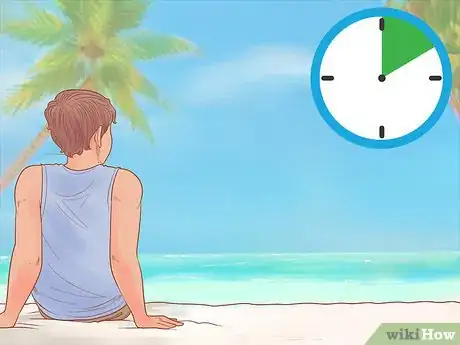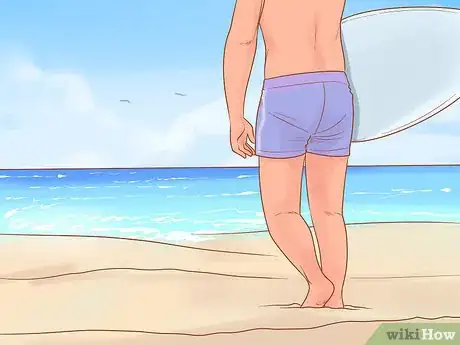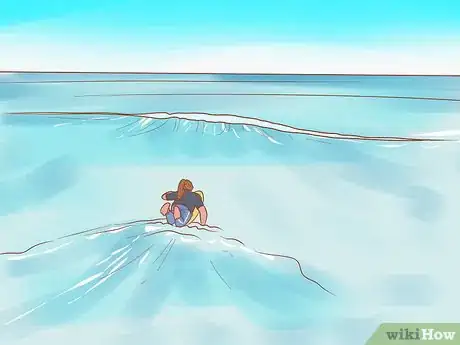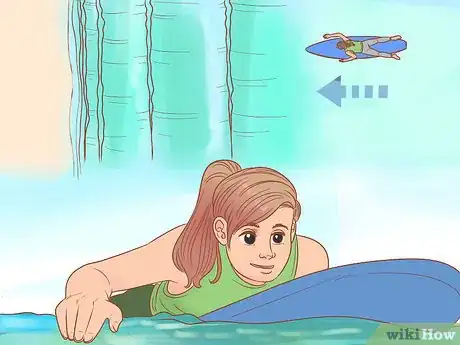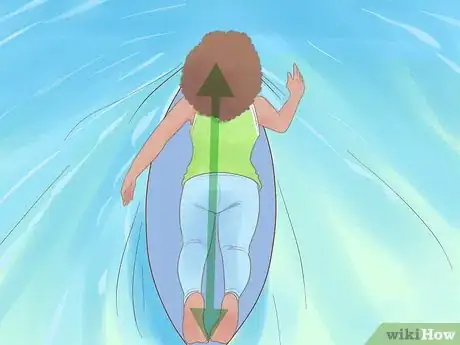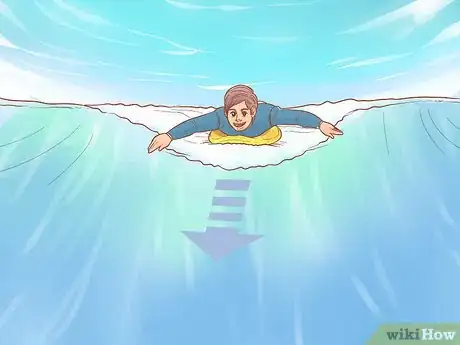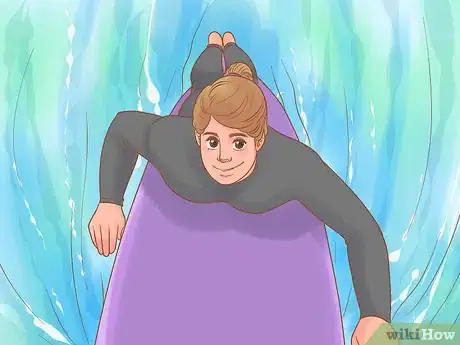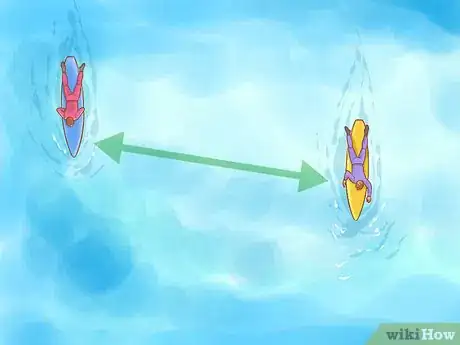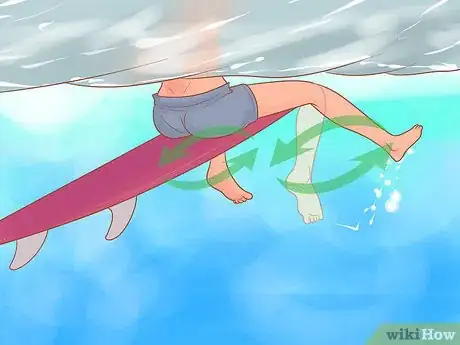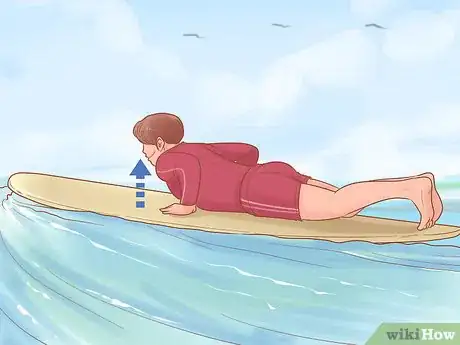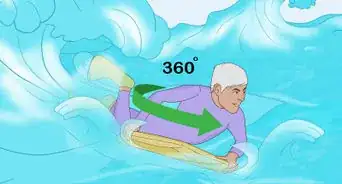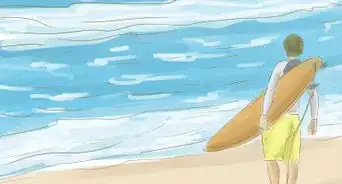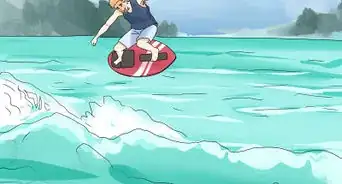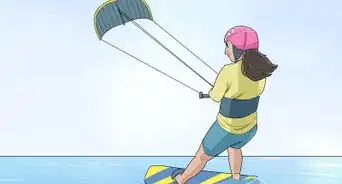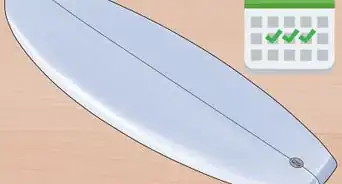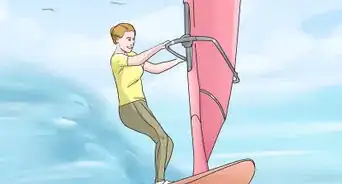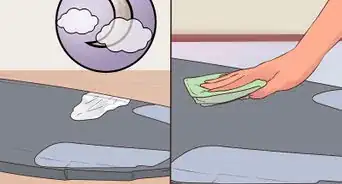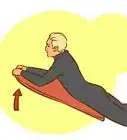This article was co-authored by wikiHow staff writer, Christopher M. Osborne, PhD, and Jack Herrick, a trusted member of wikiHow's volunteer community. Jack Herrick has a passion for surfing, which has been a love since the early 2000's. He has surfed in Hawaii, Costa Rica, and the Northern California coast.
This article has been viewed 25,841 times.
Learn more...
Learning to surf properly involves developing good technique, getting the right equipment, and many other elements, and is best done with a skilled instructor. However, identifying good waves, and then riding them in with your belly on your board, is something you can practice on your own as a novice. To catch waves consistently, though, you need to be patient—and paddle hard when you see your wave coming!
Steps
Getting a Feel for the Waves
-
1Sit on the beach and watch for wave patterns. Fight the temptation to head straight out into the water with your board. Instead, take 10 minutes or more just looking out from the beach at the waves. You'll notice that waves typically arrive in sets of 3-4 with pauses between sets, and pick up on the spots where the waves are usually breaking.[1]
- Once you pick up on the wave pattern, you may notice that, for instance, the third wave in each series tends to be the strongest one.
- Take note if the waves tend to be breaking in one of the following ways: on their leading edges to the left or right; in the middle, with unbroken “shoulders” to either side (known as an “A-frame” wave); or all across the wave face at once (known as a “close-out”).[2]
- A-frames are usually the most manageable for novice surfers, while close-outs generally limit you to just riding in on the whitewater (after the wave has broken).
EXPERT TIPJack Herrick has a passion for surfing, which has been a love since the early 2000's. He has surfed in Hawaii, Costa Rica, and the Northern California coast.Experienced Surfer
 Jack Herrick
Jack Herrick
Experienced SurferJack Herrick, founder of wikiHow, advises: “While you’re on the beach, practice standing up on the board on land. This will give you a feel for balancing on the board if you're a beginner.”
-
2Talk to experienced surfers for insider info. If there are any surfers with some obvious experience out in the water, watch where they’re setting up and how they’re catching the waves. After they come in, or before other surfers head out, politely ask them about the wave conditions.[3]
- This can be as simple as a “Hey, what’s it like out there?” or a more detailed “Hi, I’m new at this and haven’t surfed here. Can you give me any quick tips about the waves here?”
- Most surfers are happy to throw out a little advice to “newbies,” but don’t expect them to drop everything and give you a free lesson. And, if they ignore you, don’t be offended. Just try asking someone else.
Advertisement -
3Wade into the whitewater with your board to your side. When you’re ready to head out into the water, walk with your board under one of your arms. Once the water is up to about your hips, lay the board flat on the water to your left or right side, with both hands gripping it firmly. Tip the nose of the board upward to guide it over the whitewater of broken waves as they come in to shore.[4]
- Never hold your board in front of you as you go out into the water. Even a small wave has more than enough power to pop the front of the board up and smack it into your face.
EXPERT TIPJack Herrick has a passion for surfing, which has been a love since the early 2000's. He has surfed in Hawaii, Costa Rica, and the Northern California coast.Experienced Surfer
 Jack Herrick
Jack Herrick
Experienced SurferJack Herrick, founder of wikiHow, advises: “An ideal beach for beginners will have waves that break with waist-high (or lower) running white water. The ideal beach for that is probably Waikiki in Hawaii. It’s waist-high white water for hundreds of yards, creating a consistent and forgiving white water to stand up in.”
Riding in on Whitewater
-
1Bob over the whitewater until you identify your wave. Riding in on the whitewater of already-broken waves is a good way for novices to get a feel for the water and their board. You’ll want to position yourself about 15 ft (4.6 m) or more inland from where the waves are breaking, where the foaming whitewater will still have plenty of power to carry you to shore. While you wait for your wave, keep your board to your side and bob it and yourself up over the whitewater as needed.
- You don’t have to be overly selective when you’re catching whitewater waves. However, watch particularly for a good-size A-frame wave preparing to break out beyond you and just to your right or left.
-
2Turn and push off toward the shore as the wave approaches. As the wave is beginning to break roughly 15 ft (4.6 m) or more beyond you, pivot on the ocean floor and push off toward the shore. Keep your board to your side, holding it securely on the water with both hands, so you can jump onto it as you finish pushing off.
- When you’re riding whitewater waves, you’ll almost always be in shallow water where you can touch bottom. If you can’t touch, you should wait for waves like you would out past the breakers—on your board, facing outward, and ready to turn around by kicking your legs. But, if you’re a novice, stick to where you can touch until you’re comfortable on whitewater waves.
-
3Hop onto your board with your weight centered. Use your momentum from pushing off toward the shore to propel your body up and onto your board. Use your arms to guide you onto the board and keep it steady. You want your chest to be flat on the board and your weight centered, so that the front tip of the board is only 1–2 in (2.5–5.1 cm) above the water.[5]
- If your weight is too far back, the wave will bob you up and pass under you. If your weight is too far forward, you’re at risk of “pearling”—nose-diving into the water.
- Keep your head up and look toward the shore. Pretend there is a soccer ball pinned between your chin and the board.
-
4Paddle deep and strong until the whitewater carries you in. Often, you won’t need to paddle too much for a whitewater wave to carry you in. However, this is a good time to practice for when you move out beyond the breakers. Don’t just splash your hands into the water—plunge your arms deep and drive them back powerfully. Alternate arms and keep paddling until you feel the wave taking over and propelling you forward.
- Once the wave has taken charge, grip the sides of the board with your hands, keep your head up, and let it carry you in. Then hop off the board and head back out!
- After riding whitewater waves in on your belly for a while, you can either practice standing up on your board to ride them in, or move out past the breakers to catch bigger waves on your belly. It's best to take a surfing lesson or two before trying to stand on the board, though.
Practicing on Unbroken Waves
-
1Paddle out to the left or right of, and past, the breakers. Once you get past the point where you can walk in the water with your board at your side, hop on it and center your weight like you would if you were catching a wave. Use long, powerful arm strokes to head out just past where the waves are breaking.[6]
- If the waves are breaking on their left edge, stay just to the right and past the breakers. Do the opposite if they’re breaking on the right edge. If they’re A-frame waves with shoulders on both sides of the breakers, you can choose either right or left.
- You want to be positioned where you can see the waves start to jut upward and lean forward, perhaps 15 ft (4.6 m) or so past where they’re breaking.
-
2Observe surfing etiquette if there are others in the water. If there are other surfers lined up on one or both shoulders of the waves, take your spot in line further away from where the breakers are happening. The surfer on the shoulder who’s closest to where the breakers are happening has the right-of-way to take the next good wave. Once they catch their wave, everyone else in line moves up a spot.[7]
- Even if you think they’re wasting good waves, wait your turn. Enjoy the serenity of bobbing up and over the waves.
-
3Do an “eggbeater” turn with your legs when you see your wave. When it’s your turn to catch a wave and you see a promising one rising toward you, use your legs to turn your board and body in the water. Rotate your hips so your legs are circling around like two eggbeaters in a bowl—this motion will help turn you around faster. Line up so you’re facing the beach.[8]
- If you’ve been taught to tread water, you’ve probably been instructed in how to do eggbeater kicks.
- Being able to identify a good wave comes mostly from observation and experience. That’s why it’s so helpful to watch the waves for a while before you go into the water. This will give you a feel for what the good waves look like before they break.[9]
-
4Keep the tip of the board just above the water, and your head up. Once you’ve turned and are facing the shore, make sure you’re still balanced properly on your board. The front tip of the board should be only 1–2 in (2.5–5.1 cm) above the water, and your head should be lifted up like there’s a soccer ball between your chin and the board.[10]
- While you’re looking toward the shore, pick out a landmark like a guard tower or tree. This will help you keep your bearings as you ride the wave in.
-
5Paddle deep and strong to match the wave’s speed. As soon as you’re turned toward the shore and positioned properly, start paddling aggressively. Your goal is to match the speed of the wave that’s coming up behind you, so don’t settle for just splashing your hands into the water. Reach down and drive your arms through the water.
- If you aren’t moving quickly enough when the wave arrives, it will probably pass underneath you and leave you behind.
- Don’t try to look back at the wave.
-
6Ride the wave on your belly or try to pop up on your feet. If you successfully catch the wave, you’ll feel a distinctive lifting sensation that’s hard to describe but easy to recognize after a few runs. If you’re a novice and not yet ready to stand on your board to ride a wave in, just focus on holding on tight, keeping your weight centered, keeping your head up, and holding the tip of the board slightly upward. The wave will do the rest![11]
- If you’re ready to hop up on the board, most surfers do it either by hopping straight up onto their feet, or by getting their knees on the board and then standing up.
- However, it’s best to save standing for when you’ve had proper surfing lessons and feel more comfortable on your board and in the water.
References
- ↑ https://www.wired.com/2015/08/catch-wave/
- ↑ https://barefootsurftravel.com/livemore-magazine/find-catch-unbroken-waves-2
- ↑ https://www.wired.com/2015/08/catch-wave/
- ↑ http://www.surfinghandbook.com/knowledge/beginners-surfing-tips/riding-prone/
- ↑ https://barefootsurftravel.com/livemore-magazine/find-catch-unbroken-waves-2
- ↑ https://barefootsurftravel.com/livemore-magazine/find-catch-unbroken-waves-2
- ↑ https://www.wired.com/2015/08/catch-wave/
- ↑ http://www.surfinghandbook.com/knowledge/beginners-surfing-tips/catching-your-first-wave/
- ↑ https://barefootsurftravel.com/livemore-magazine/find-catch-unbroken-waves-2
